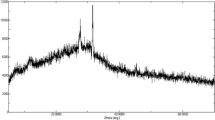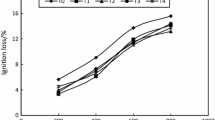Abstract
In the present study, the potential effects of physical, chemical and electro-kinetic properties of pumice on the strength development of pumice blended cements (PBC) were examined and documented. A significant relationship between zeta potential of pumice samples, setting time and water demand of PBC was found. A relationship between the chemical content of pumice samples and compressive strength of PBC was also observed. However, zeta potential of the pumice samples was found to be less effective in strength development. Despite the lower clinker content, the setting time of the PBC samples was shorter than control specimen. 30 % pumice replacement by clinker resulted in 5–28 % reduction in 28-day strength depending on the characteristics of the pumice samples and grinding time.









Similar content being viewed by others
References
Alexander KM, Davis CES (1960) Effect of alkali on the strength of Portland cement paste. Aust J Appl Sci 11:146–156
Anwar Hossain KM (2004) Properties of volcanic pumice based cement and lightweight concrete. Cem Concr Res 34:283–291
ASTM C618 (2003) Standard specification for coal fly ash and raw or calcined natural pozzolan for use in concrete. American society for testing and materials, ASTM International, West Conshohocken
Blanco Varela MT, Martínez Ramírez S, Ereña I, Gener M, Carmona P (2006) Characterization and pozzolanicity of zeolitic rocks from two cuban deposits. Appl Clay Sci 33:149–159
Carter DL, Mortland MM, Kemper WD (1986) Methods of soil analysis, Part I. Physical and mineralogical methods—Agronomy monograph no. 9, 2nd edn. American Society of Agronomy—Soil Science Society of America, Madison, USA
Depci T, Efe T, Tapan M, Özvan A, Açlan M, Uner T (2012) Chemical characterization of Patnos Scoria (Ağrı, Turkey) and its usability for production of blended cement. Physicochem Probl Min Process 48(1):303–315
Ersoy B, Sariisik A, Dikmen S, Sariisik G (2010) Characterization of acidic pumice and determination of its electrokinetic properties in water. Powder Technol 197:129–135
Hodne H, Saasen A (2000) The effect of the cement zeta potential and slurry conductivity on the consistency of oil-well cement slurries. Cem Concr Res 30:1767–1772
Hunter RJ (1993) Foundations of colloid science. Oxford University Press, Oxford
Hunter RJ (1981) Zeta potential in colloid science. Academic Press Inc., San Diego
Kazuhiro Y, Ei-ichi T, Kenji K, Tomoyuki E (2002) Adsorption characteristics of superplasticizers on cement component minerals. Cem Concr Res 32:1507–1513
Lea FM (1976) The chemistry of cement and concrete. Edward Arnold Ltd, London
Lyklema J (1991) Fundamentals of interface and colloid science. Academic Press, Amsterdam
Massazza F (1998) Pozzolana and pozzolanic cements. In: Hewlett PC (ed) Lea’s chemistry of cement and concrete, 4th edn. Elsevier, London
Neubauer CM, Yang M, Jennings HM (1998) Interparticle potential and sedimentation behavior of cement suspensions: effects of admixtures. Adv Cem Based Mater 8:17–27
Ozvan A, Tapan M, Erik O, Efe T, Depci T (2012) Compressive strength of scoria added Portland cement concretes. Gazi Univ J Sci 25(3):769–775
Pan S, Tseng D, Lee CC, Lee C (2003) Influence of the fineness of sewage sludge ash on the mortar properties. Cem Concr Res 33:1749–1754
Perraki Th, Orfanoudaki A (2004) Study of thermally treated kaolinite. Miner Wealth 130:33–40
Plank J, Hirsch C (2007) Impact of zeta potential of early cement hydration phases on superplasticizer adsorption. Cem Concr Res 37:537–542
Poon CS, Lam L, Kou SC, Lin ZS (1999) A study on the hydration rate of natural zeolite blended cement pastes. Constr Build Mater 13:427–432
Sabir B, Wild S, Bai J (2001) Metacaolin and calcined clays as pozzolan for concrete: a review. Cem Concr Compos 23:441–454
Sersale R, Frigione G (1985) Natural zeolites as constituents of blended cements. La Chimica e l’industria 67:177–180
Shannag M (2000) High strenght concrete containing natural pozzolan and silica fume. Cem Concr Compos 22:399–406
Shayan II (1989) Influence of NaOH on mechanical properties of cement paste and mortar with and without reactive aggregate. In: 8th international conference on alkali—aggregate reaction. Society of Materials Sciences, Kyoto, Japan, pp 715–720
Taşkın C (1977) Van-Ağrı illeri yörelerinde bazı pomza (bims) zuhurlarının araştırılması hakkında rapor. Maden Tetkik ve Arama Enstitüsü Endüstriyel Hammaddeler Daire Başkanlığı Yapı Taşları ve Malzemeleri Servisi, Ankara, Turkey (in Turkish)
Tavare NS, Garside J (1982) The characterization of growth dispersion. Industrial crystallization. North-Holland Publishing, Amsterdam
TS EN 196-1 (2009) Methods of testing cement—Part 1: determination of strength. Tuskish Standards Institutions, TSE, Ankara (in Turkish)
TS EN 196-3 (2002) Methods of testing cement-Part 3: Determination of setting time and soundness. Turkish Standards Institution, TSE, Ankara (in Turkish)
TS EN 196-6 (2000) Methods of testing cement-Part 3: determination of fineness. Turkish Standards, TSE, Ankara (in Turkish)
TS EN 197-1 (2002) Cement-Part 1: Compositions and conformity criteria for common cements. Turkish Standards Institution, TSE, Ankara (in Turkish)
TS EN 197-2 (2002) Cement-Part 2: Conformity evaluation. Turkish Standards Institution, TSE, Ankara (in Turkish)
Tunç S, Duman O (2009) Effects of electrolytes on the electrokinetic properties of pumice suspensions. J Dispers Sci Technol 30:548–555
Walker R, Pavía S (2010) Effect of pozzolan properties on the properties of building composites. In: Ní Nualláin NA, Walsh D, West R, Cannon E, Caprani C, McCabe B (eds) BCRI Bridge Infrastructure Concrete Research Ireland University of Cork
Yilmaz B (2009) Effects of molecular and electrokinetic properties of pozzolans on hydration. ACI Mater J 106:128–137
Acknowledgments
This research is partially funded by Yuzuncu Yil University (Project Number: 2010-FBE-YL107). The authors would like to thank to Quality Control Team of Askale Van Cement Factory, for their contributions in performing standard cement tests.
Author information
Authors and Affiliations
Corresponding author
Rights and permissions
About this article
Cite this article
Tapan, M., Depci, T., Özvan, A. et al. Effect of physical, chemical and electro-kinetic properties of pumice on strength development of pumice blended cements. Mater Struct 46, 1695–1706 (2013). https://doi.org/10.1617/s11527-012-0008-y
Received:
Accepted:
Published:
Issue Date:
DOI: https://doi.org/10.1617/s11527-012-0008-y




